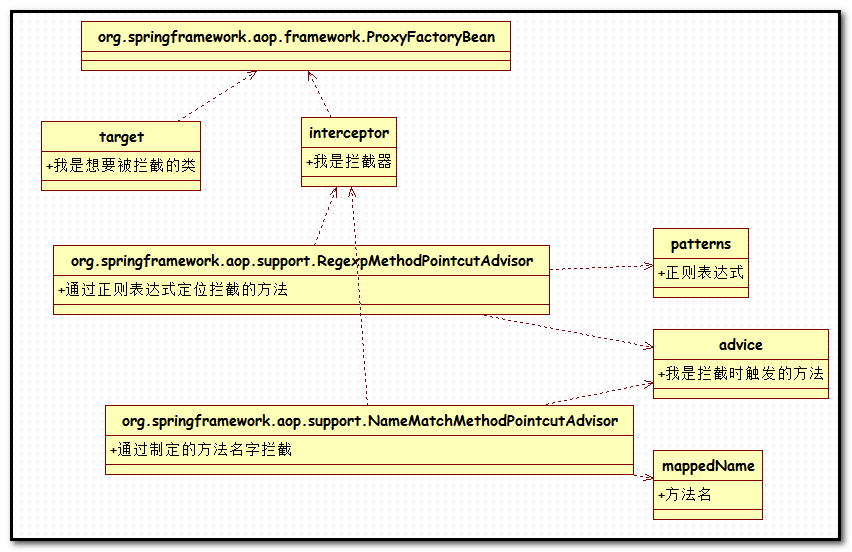基于配置的Spring AOP
前面几篇学习了Spring的依赖注入,这篇开始学习另一个核心功能——面向切面编程AOP。
通过本文,你可以了解到:
1 Spring xml规范
2 通过配置文件实现面向切面编程
3 对比与传统AOP编程
Spring的xml文件
Spring的xml一般起名叫做bean.xml或者xxxapplication.xml这种,然后放在src下通过ClassPathXmlApplicationContext进行加载。文件的内容如下:
<?xml version="1.0" encoding="UTF-8"?>
<beans xmlns="http://www.springframework.org/schema/beans"
xmlns:xsi="http://www.w3.org/2001/XMLSchema-instance"
xmlns:aop="http://www.springframework.org/schema/aop"
xmlns:tx="http://www.springframework.org/schema/tx"
xsi:schemaLocation="http://www.springframework.org/schema/beans http://www.springframework.org/schema/beans/spring-beans-2.0.xsd
http://www.springframework.org/schema/aop http://www.springframework.org/schema/aop/spring-aop-2.0.xsd
http://www.springframework.org/schema/tx http://www.springframework.org/schema/tx/spring-tx-2.0.xsd"> <bean id="audience"class="com.spring.test.aop.Audience"/> <aop:config>
</aop:config>
</beans>
最上面的是xml的编码,这个就不解释了。
下面的<beans>是Spring的配置标签,beans里面几个重要的属性:
xmlns:
是默认的xml文档解析格式,即spring的beans。地址是http://www.springframework.org/schema/beans。
通过设置这个属性,所有在beans里面声明的属性,可以直接通过<>来使用,比如<bean>等等。
xmlns:xsi:
是xml需要遵守的规范,通过URL可以看到,是w3的统一规范,后面通过xsi:schemaLocation来定位所有的解析文件。
xmlns:aop:
这个是重点,是我们这里需要使用到的一些语义规范,与面向切面AOP相关。
xmlns:tx:
Spring中与事务相关的配置内容。
一个XML文件,只能声明一个默认的语义解析的规范。
例如上面的xml中就只有beans一个是默认的,其他的都需要通过特定的标签来使用,比如aop,它自己有很多的属性,如果要使用,前面就必须加上aop:xxx才可以。比如上面的aop:config。
类似的,如果默认的xmlns配置的是aop相关的语义解析规范,那么在xml中就可以直接写config这种标签了。
基于配置的AOP编程过程
首先,如果要在工程中使用AOP需要几个jar包:
1 Aop的核心包,即org.springframework.aop-xxx.jar
2 Spring的联盟包:aopalliance-1.0.jar
3 aspectJ相关的jar包:aspectjrt.jar aspectjweaver.jar
4 如果使用了动态代理,还需要添加cglib相关的jar包:cglib.zip
首先需要一个AOP的切面类,用于定义各种响应事件
package com.spring.test.aop;
public class Audience {
public void takeSeats(){
System.out.println("The audience is taking their seats.");
}
public void turnOffCellPhones(){
System.out.println("The audience is turning off their cellphones");
}
public void applaud(){
System.out.println("CLAP CLAP CLAP");
}
public void demandRefund(){
System.out.println("Boo! We want money back");
}
}
然后在bean.xml中编写aop:config的相关内容:
...省略beans的定义内容
<bean id="audience" class="com.spring.test.aop.Audience"/>
<bean id="sax" class="com.spring.test.setter.Saxophone"/>
<bean id="kenny" class="com.spring.test.setter.Instrumentalist">
<property name="song" value="Jingle Bells" />
<property name="age" value="25" />
<property name="instrument" ref="sax"/>
</bean>
<aop:config proxy-target-class="true">
<aop:aspect ref="audience">
<aop:pointcut id="performance" expression="execution(* com.spring.test.action1.Performer.perform(..))"/>
<aop:before pointcut-ref="performance" method="takeSeats"/>
<aop:before pointcut-ref="performance" method="turnOffCellPhones"/>
<aop:after-returning pointcut-ref="performance" method="applaud"/>
<aop:after-throwing pointcut-ref="performance" method="demandRefund"/>
</aop:aspect>
</aop:config>
</beans>
这里面的aop:pointcut 就是使用AspectJ来定位的。意思是:当执行com.spring.test.action1.Performer的perform方法时,就会触发该切面的事件响应。
而Performer以及Instrumentalist等等的代码,就在下面简单的都罗列出来了:
配置文件:bean.xml
<?xml version="1.0" encoding="UTF-8"?>
<beans xmlns="http://www.springframework.org/schema/beans"
xmlns:xsi="http://www.w3.org/2001/XMLSchema-instance"
xmlns:aop="http://www.springframework.org/schema/aop"
xmlns:tx="http://www.springframework.org/schema/tx"
xsi:schemaLocation="http://www.springframework.org/schema/beans http://www.springframework.org/schema/beans/spring-beans-2.0.xsd
http://www.springframework.org/schema/aop http://www.springframework.org/schema/aop/spring-aop-2.0.xsd
http://www.springframework.org/schema/tx http://www.springframework.org/schema/tx/spring-tx-2.0.xsd"> <bean id="audience" class="com.spring.test.aop.Audience"/> <bean id="sax" class="com.spring.test.setter.Saxophone"/>
<bean id="kenny" class="com.spring.test.setter.Instrumentalist">
<property name="song" value="Jingle Bells" />
<property name="age" value="25" />
<property name="instrument" ref="sax"/>
</bean> <aop:config proxy-target-class="true">
<aop:aspect ref="audience">
<aop:pointcut id="performance" expression="execution(* com.spring.test.action1.Performer.perform(..))"/> <aop:before pointcut-ref="performance" method="takeSeats"/>
<aop:before pointcut-ref="performance" method="turnOffCellPhones"/>
<aop:after-returning pointcut-ref="performance" method="applaud"/>
<aop:after-throwing pointcut-ref="performance" method="demandRefund"/>
</aop:aspect>
</aop:config>
</beans>
表演者接口:Performer.java
package com.spring.test.action1;
public interface Performer {
void perform() throws PerformanceException;
}
表演者实现类:Instrumentalist.java
package com.spring.test.setter; import com.spring.test.action1.PerformanceException;
import com.spring.test.action1.Performer; public class Instrumentalist implements Performer{
private String song;
private int age;
private Instrument instrument;
public int getAge() {
return age;
}
public void setAge(int age) {
this.age = age;
}
public String getSong() {
return song;
}
public void setSong(String song) {
this.song = song;
}
public Instrument getInstrument() {
return instrument;
}
public void setInstrument(Instrument instrument) {
this.instrument = instrument;
}
public Instrumentalist(){}
public Instrumentalist(String song,int age,Instrument instrument){
this.song = song;
this.age = age;
this.instrument = instrument;
}
public void perform() throws PerformanceException {
System.out.println("Instrumentalist age:"+age);
System.out.print("Playing "+song+":");
instrument.play();
}
}
内部bean接口:Instrument.java
package com.spring.test.setter;
public interface Instrument {
public void play();
}
内部bean实现类:Saxophone.java
package com.spring.test.setter;
public class Saxophone implements Instrument {
public Saxophone(){}
public void play() {
System.out.println("TOOT TOOT TOOT");
}
}
测试主函数:main
package com.spring.test.setter; import org.springframework.context.ApplicationContext;
import org.springframework.context.support.ClassPathXmlApplicationContext; import com.spring.test.action1.PerformanceException; public class test {
public static void main(String[] args) throws PerformanceException {
ApplicationContext ctx = new ClassPathXmlApplicationContext("bean.xml"); Instrumentalist performer = (Instrumentalist)ctx.getBean("kenny");
performer.perform(); }
}
运行结果:
The audience is taking their seats.
The audience is turning off their cellphones
Instrumentalist age:25
Playing Jingle Bells:TOOT TOOT TOOT
CLAP CLAP CLAP
通过这种声明方式,可以 快速的实现切点与切面的整合,成为下面这种格式的新代码:
class{
try{
audience.takeSeats();
audience.turnOffCellphones();
performance.perform();
audience.applaud();
}catch(Exception){
audience.demandRefund();
}
}
面向切面的好处,要在实际工作中多加领会才可以,常用的场景就是日志的记录了。
与传统的AOP编程相比
前面也做过一个传统的spring aop的实现方法:http://www.cnblogs.com/xing901022/p/4143696.html
不得不说,通过ProxyFactoryBean达到的面向切面的编程,过于复杂,光是那几个功能就要好好理解一番。

而基于配置的AOP使用就要简单的多,只需要一个切面的程序,然后通过配置文件就可以完全解耦的融入到切点中。
基于配置的Spring AOP的更多相关文章
- 基于注解的Spring AOP的配置和使用
摘要: 基于注解的Spring AOP的配置和使用 AOP是OOP的延续,是Aspect Oriented Programming的缩写,意思是面向切面编程.可以通过预编译方式和运行期动态代理实现在不 ...
- Spring Aop(七)——基于XML配置的Spring Aop
转发:https://www.iteye.com/blog/elim-2396043 7 基于XML配置的Spring AOP 基于XML配置的Spring AOP需要引入AOP配置的Schema,然 ...
- 基于注解的Spring AOP示例
基于注解的Spring AOP示例 目录 在XML配置文件中开启 @AspectJ 支持 声明切面及切入点 声明通知 测试 结语 在XML配置文件中开启 @AspectJ 支持 要使用Spring的A ...
- 基于注解的Spring AOP的配置和使用--转载
AOP是OOP的延续,是Aspect Oriented Programming的缩写,意思是面向切面编程.可以通过预编译方式和运行期动态代理实现在不修改源代码的情况下给程序动态统一添加功能的一种技术. ...
- 基于Aspectj表达式配置的Spring AOP
AOP(Aspect-Oriented Programming, 面向切面编程):是一种新的方法论, 是对传统OOP(Object-Oriented Programming, 面向对象编程)的补充. ...
- 基于配置的Spring MVC3
网上查找的spring mvc3大部分都是基于注射的方式,总感觉注射有点怪怪.不利于后期扩展和项目管理,于是特意写下这篇基于xml配置的Spring MVC3.以供大家參考. 怎么建立web项目和下载 ...
- 基于 Annotation 的 Spring AOP 权限验证方法的实现
1. 配置 applicationContext 在 Spring 中支持 AOP 的配置非常的简单,只需要在 Spring 配置文件 applicationContext.xml 中添加: < ...
- 基于注解的Spring AOP拦截含有泛型的DAO
出错场景 1.抽象类BaseDao public abstract class BaseDao<T> { public BaseDao() { entityClass = (Class&l ...
- 基于XML配置的spring aop增强配置和使用
在我的另一篇文章中(http://www.cnblogs.com/anivia/p/5687346.html),通过一个例子介绍了基于注解配置spring增强的方式,那么这篇文章,只是简单的说明,如何 ...
随机推荐
- python-sort()/sorted()比较
Sorting Lists sorted(iterable,key=None,reverse=False),does not mutate list, must assign result to a ...
- Oracle分区表管理的一些笔记
[转自] http://www.linuxidc.com/Linux/2011-07/38381.htm Oracle分区表的管理笔记(仅限于对普通表,即堆表的分区管理,IOT跟CLUSTER TAB ...
- 子查询及pymysql
子查询 子查询指的是当一个查询语句被作为另一个查询语句的条件时,该查询语句就称之为子查询(内层查询) 可以将一个大问题 拆分几个小的问题 然后一步一步来查询 需求:财务不有哪些人 ),sex ),jo ...
- PIE SDK矢量数据的修改
1.功能简介 目前PIE SDK支持矢量数据的修改或删除,下面对矢量数据的投影转换功能进行介绍. 2.功能实现说明 2.1. 矢量数据的修改 2.2. 实现思路及原理说明 第一步 获取需要修改的矢量数 ...
- docker 解决容器时间与主机时间不一致的问题
环境: 1.阿里云ecs服务器 2.docker 3.docker镜像 centos7.4.1708 方法一: 查看主机时间: [root@iZbp1625jeg61bc2zzfcotZ docker ...
- NPOI开发手记
目录 注意事项 读取Excel 创建Excel表 保存Excel 行 列 单元格样式 添加公式 Dataset.DataGridView转换Excel帮助类 NPOI其实就是POI的.NET移植 项目 ...
- RabbitMQ基础知识篇
1.Linux安装RabbitMQ. 参考网址:RPM安装RabbitMQ 仔细阅读. 先安装erlang: su -c 'rpm -Uvh http://mirrors.neusoft.edu. ...
- TOJ 4394 Rebuild Road
描述 Once,in a kingdom,there are N cities.M roads have been buit such that from one city you can reach ...
- HDU 5222 ——Exploration——————【并查集+拓扑排序判有向环】
Exploration Time Limit: 30000/15000 MS (Java/Others) Memory Limit: 131072/131072 K (Java/Others)T ...
- sqlite3在别的目录写文件的问题
今天碰到一个文件,就是sqlite数据不能把db创建在别的目录下.找了好久不得其解.后来换了一个sqlite jar包就好了. 原来我用的是sqlite-nested 内嵌的jar包. 换成这里的包h ...
